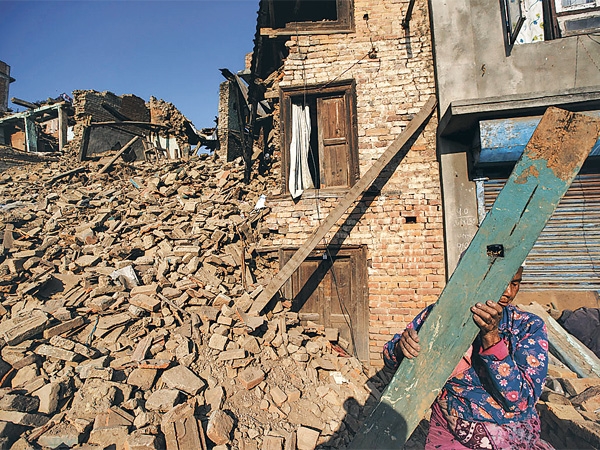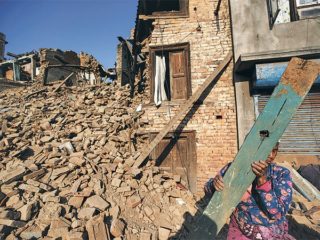From The Kathmandu Post (22 May, 2015)
If earthquake volunteers become ‘political’, the country may go somewhere
Historically, before the analogue era and the digital era, Nepalis mentally marked time in relation to before or after manmade or natural catastrophic events, such as the Kot Massacre, great floods, or great earthquakes. Just as the 1934 earthquake became such a marker (‘Nabbe Saal ko bhainchalo’), one expects the Bahattar Saal ko bainchalo to denote a great transformation between what went prior to and what followed April 2015.
The Bikram Calendar year 2072 must be deliberately deployed as a transition for Nepal from a dysfunctional state of the modern era to a vibrant state, one that does justice to the genius of its people and the possibilities of its geography.
We must, of course, start with a sense of perspective in terms of what the earthquake did and did not do. It brought disaster to 14 of Nepal’s 75 districts, though the economic and psycho-social impact has coursed countrywide. The quake exposed the ennui of the political class, and yet, also proved the resilience of both the people and the state. It brought out the best of urban and rural citizens at the grassroots, and allowed a whole new category of young professionals to respond to disaster in myriad ways.
‘After 2072’ will be better for the people than ‘before 2072’ only if the political class, intelligentsia, and civil society can rise to the challenge of ensuring economic growth and social justice in the process of national construction. The multiple jolts of the past month demand that we evaluate our conduct of affairs, from politics to housing, livelihood, schooling, heritage, tourism, and employment, so that the transition from one era to the next is based on science, logic, and the knowledge of terrain and society.
At the base of everything lies the need for a democratic constitution and elected local government, on whose foundation the economy will have to be made to expand exponentially. Nepal must emerge as an exemplary country that rises from the dust and ashes.
Road & houses
The jolts of April have turned many givens and positionings on their head, from how we countenance roads and highways to the use of building technology and materials. The district roads that have been built with such engineering and environmental flaws over the last decades turned out to be a boon in terms of relief and rescue (though monsoon would have been a different matter). Motorcycles made it where the four-wheelers could not in these rural tracks, though further out in many parts, life without relief continues.
Post-earthquake is also time to consider the type of highways that have worked for us. A comparative analysis is needed of the ridgeline-hugging Tribhuvan Rajpath (byroad ko bato), the riverside-oriented Arniko Rajmarg, the much-buttressed Sindhuli Highway, and the wide Madhya Pahadi Lokmarg snaking its way through the mid-hills.
Post-quake is also time to reconsider rural and urban dwellings, in terms of household use as well as economic utility. The earthquake seems to have arrived to tell us to consider modern materials and methods, items and technology that were not available to our ancestors whose ways and means have survived till the present. Despite the well-maintained mud-mortar monuments and dwellings that remain standing, the public push will be for cement constructions now more than earlier. How to adjust this public desire by bringing together practicality, comfort, security, cost, aesthetics, emotions, and economic opportunity will be one of the bigger challenges of the post 2072 era.
Just as innovations are required in housing, so they will be needed in three other critical areas—government school instruction, building of livelihoods, and restoration of built as well as intangible heritage. The gift of 2072 could be that it leads professionals—from bureaucrats to planners to activists—to soften their certitudes, respect the common sense of the common folk, and be true fellow travellers along the road to recovery and construction.
Bungamati
The heritage town of Bungamati, home of Bungdeo, may be our bellwether as to whether the country regains its footing or will simply accelerate in its decline. A couple of weeks before the earthquake, some locals and outsiders were discussing how to promote heritage tourism, which had yet to begin in Bungamati. One suggestion was that the townsfolk maintain the traditional outward look of the houses but make the indoors comfortable for visitors. It became evident that that was easier said than done.
The destruction of hundreds of dwellings in the town means that the inhabitants are now forced to make a choice, and Bungamati could show the way to Khokana, Sankhu, Harisiddhi, as well as the three inner cities. In the absence of a convincing campaign for mud mortar, the townspeople will opt for cement and concrete beam-pillars, and the challenge for professionals will be to make this work while maintaining the historical ambience of Bungamati.
In the hills, there are suggestions for relocation of settlements, and the worry is that this may be done to merely exhibit urgency while neglecting the need to link housing to livelihoods. Some consultants are already doing the rounds of the political leaders with Powerpoint presentations of nice prefab townhouses all in a row, without reference to livestock, granary, or vegetable patch. As for the particular gentleman in government who wants to introduce a grid-pattern socialist architecture to Bungamati, including wide roads for ‘firetrucks to make it in’, please note that there are also narrow fire engines available.
What we need for now is an intersect between local needs, the historical continuity of architecture, and the introduction of thoughts and concepts that will make Bungamati rise once again without losing touch with its history.
Lift the blockade
But whether it is new architecture or new economy, it is not enough to hope for some good to come out of the Spring of 2072. A Twitter post or a Facebook ‘like’ do not make for activism. Nothing will happen without a strong civil society response and the building of multiple mutually-supporting networks to monitor and watchdog the work and response of political parties, government, and donor organisations in the days ahead.
The most important contribution to help the country spring back to life after 2072 will be to force those involved to lift the blockade they have placed on the writing of a constitution through agreed procedure, and force the same individuals to not stand in the way of holding elections to local bodies (villages, districts, municipalities). This would electrify the people, give them energy to rise to the challenge of rebuilding lives and economy.
What 2072 has given us is a new group of capable and positive-spirited volunteers, who have risen spontaneously to the needs of a populace devastated. This is a departure from the slow-moving organisations now populated by ‘development professionals’. If this new category can become positively politicised, then nothing can stop Nepal rising from the dust of 2072, to achieve what the polity has not been able to since it entered the modern era in 2007 (1950).
Like the country, these volunteers will be making the transition from relief/rehabilitation to reconstruction. Their contribution, based on an understanding of the interplay between history, politics, and economy, will ensure that Nepal after 2072 will be paradigmatically different from Nepal before 2072.
